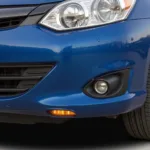Fixing a car bumper yourself can be a rewarding DIY project, saving you time and money. This guide will walk you through the process of how to repair car bumper at home, covering everything from minor scuffs to more significant damage, providing you with the knowledge and confidence to tackle this common car repair.
Repairing a minor scuff on your car bumper is often easier than you think. car bumper scuff repair at home. For deeper scratches or cracks, however, a more involved approach is required. Understanding the type of damage your bumper has sustained is the first step towards a successful repair.
Assessing the Damage and Gathering Supplies
Before you begin, carefully inspect the bumper to determine the extent of the damage. Is it a simple scuff, a deep scratch, or a crack? The repair method will vary depending on the severity. Once you’ve assessed the damage, gather the necessary supplies. This might include sandpaper, primer, paint, clear coat, plastic filler (for cracks and dents), masking tape, and a cleaning solution. Having everything ready will streamline the repair process.
What if the damage is more extensive than a simple scuff? car bumper repair at home can often handle these situations too. Remember to always prioritize safety and wear appropriate protective gear like gloves and eye protection.
Step-by-Step Guide to Repairing a Car Bumper
- Clean the Damaged Area: Thoroughly clean the damaged area with soap and water, followed by a dedicated cleaning solution to remove any dirt, grease, or wax. This will ensure proper adhesion of the repair materials.
- Sand the Affected Area: Use sandpaper to smooth out the damaged area. Start with a coarser grit and gradually move to a finer grit for a smooth finish. For deeper scratches or cracks, you may need to use plastic filler. Apply the filler according to the manufacturer’s instructions and allow it to dry completely before sanding.
- Apply Primer: After sanding, apply a thin, even coat of primer to the repaired area. This will help the paint adhere better and provide a uniform surface. Let the primer dry completely.
- Paint the Bumper: Choose a paint that matches your car’s color. Apply several thin coats of paint, allowing each coat to dry before applying the next. This will prevent runs and ensure a smooth, even finish.
- Apply Clear Coat: Once the paint is dry, apply a clear coat to protect it and give it a glossy finish. Allow the clear coat to dry completely before handling the bumper.
How to Repair a Cracked Bumper
Cracked bumpers require a slightly different approach. After cleaning and sanding, you’ll need to use a plastic welding kit or a strong adhesive specifically designed for plastic bumpers. Follow the product instructions carefully for the best results. repair car bumpers provides a detailed guide on handling these types of repairs. Remember, patience and attention to detail are crucial when repairing a cracked bumper.
“When repairing a cracked bumper, ensuring proper adhesion is paramount,” says automotive expert, David Miller, ASE Certified Master Technician. “Using a high-quality plastic adhesive designed for automotive applications is essential for a long-lasting repair.”
Choosing the Right Glue for Plastic Bumper Repair
The type of glue you use is crucial for a successful plastic bumper repair. best glue for plastic car bumper repair offers valuable information on selecting the appropriate adhesive. Two-part epoxy adhesives are often recommended for their strength and durability.
Repairing a Black Plastic Bumper
Black plastic bumpers are common and often require specific techniques for repair. how to repair black plastic car bumper offers a comprehensive guide to addressing these particular challenges.
“Black plastic bumpers are susceptible to fading and UV damage,” notes Dr. Sarah Chen, Materials Science Engineer. “Using a UV-resistant clear coat is crucial for protecting the repaired area and preventing future damage.”
In conclusion, repairing a car bumper at home is achievable with the right tools, materials, and guidance. By following the steps outlined in this article, you can save money and restore your bumper to its former glory. Remember to always assess the damage carefully and choose the appropriate repair method.
FAQ
- Can I repair a dented bumper at home?
- What type of sandpaper should I use for bumper repair?
- How long does it take for plastic filler to dry?
- Can I use spray paint for bumper repair?
- How can I match my car’s paint color?
- What is the best way to clean a car bumper before repair?
- How long does the repair typically last?
For further assistance, please contact us via WhatsApp: +1(641)206-8880, or Email: [email protected]. Our customer service team is available 24/7.



